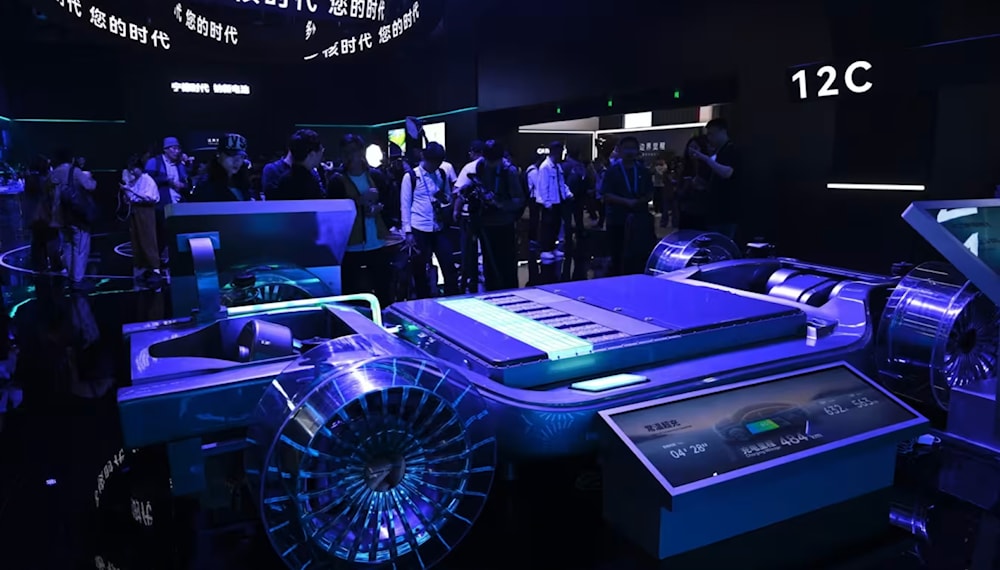China's CATL unveils sodium-ion battery in bid to reshape EV landscape
The sodium-ion battery, branded under the Naxtra name, is set to enter limited production in June with small batteries for heavy-duty vehicle starters, followed by full-scale electric vehicle battery production in December.
-

CATL showed off its second-generation Shenxing superfast charging battery at its tech day in Shanghai (AFP)
Chinese battery manufacturer CATL has unveiled a new sodium-ion battery it claims could revolutionize electric mobility by offering a safer, more affordable alternative to lithium-based technology. Announced just before the opening of the Shanghai Motor Show, the launch was part of a broader showcase that included multiple next-generation battery systems aimed at transforming the global EV market.
Speaking at the unveiling event in Shanghai, CATL's chief marketing officer, Luo Jian, declared:
"We will achieve mass production by the end of the year. It will restructure the whole industry."
The sodium-ion battery, branded under the Naxtra name, is set to enter limited production in June with small batteries for heavy-duty vehicle starters, followed by full-scale electric vehicle battery production in December. CEO Robin Zeng stated that the sodium-ion batteries have "emerged from the labs and are now ready for commercial-scale production." He added that the technology could replace up to half of the lithium iron phosphate (LFP) battery market.
Naxtra batteries offer an energy density of 175 Wh/kg, comparable to LFP cells, and are designed to function in extreme temperatures ranging from -40°C to +70°C, making them particularly well-suited for cold climates. They also boast an impressive lifespan of over 10,000 charge cycles, positioning them as a long-term, cost-effective solution in the EV sector. With a driving range of 500 kilometers (310 miles), CATL's sodium-ion tech promises robust performance without the need for costly or rare metals.
The next leap in battery tech is about to be revealed.
— CATL (@catl_official) April 21, 2025
Join us LIVE for CATL TECH DAY 2025, where we break through the limits of battery and redefine what’s possible.
📅 Date: April 21st, 2025
🕒 Time: 15:00 (UTC+8) https://t.co/ZycVMDxbTx
CATL also revealed the second generation of its Shenxing ultra-fast charging battery, which is capable of delivering 800 kilometers of range, and can recover 520 kilometers of driving range in just five minutes of charging. The battery maintains performance in cold weather, charging from 5% to 80% in just 15 minutes at -10°C. This technology will power 67 vehicle models from leading Chinese EV makers, including Zeekr, Nio, and Avatr.
Battery breakthrough
To further expand its technological edge, CATL introduced the Freevoy dual battery system, which uses a dual-core architecture to ensure that one battery can support a vehicle if the other fails—an especially valuable feature for autonomous driving applications.
Technical director Gao Huan said that the dual system will offer more safety, particularly for self-driving cars, by preventing failure if one of the two batteries malfunctions. Though a production date has not been announced, Gao confirmed that one automaker is already integrating the system into its autonomous vehicle design.
The Freevoy system supports flexible battery pairings—including sodium-LFP and NCM-LFP—and can enable driving ranges that exceed 1,500 kilometers (932 miles) on a single charge.
Read more: Chinese EV brands setting the global benchmark of industry
Despite these advancements, CATL faces international hurdles. The company is facing increased scrutiny from the US, where President Donald Trump's tariffs on Chinese goods may inflate prices for EV components. Furthermore, the US Defense Department has listed CATL as having alleged links to the Chinese military, claims the company firmly denies. CATL executives declined to address these political issues during the event.
Nevertheless, CATL remains the world's largest EV battery supplier, partnering with global automakers like Tesla, Mercedes-Benz, BMW, and Volkswagen. Its new innovations—particularly the move toward mass-market sodium-ion production—position it at the forefront of the next chapter in electric vehicle evolution.

 4 Min Read
4 Min Read










